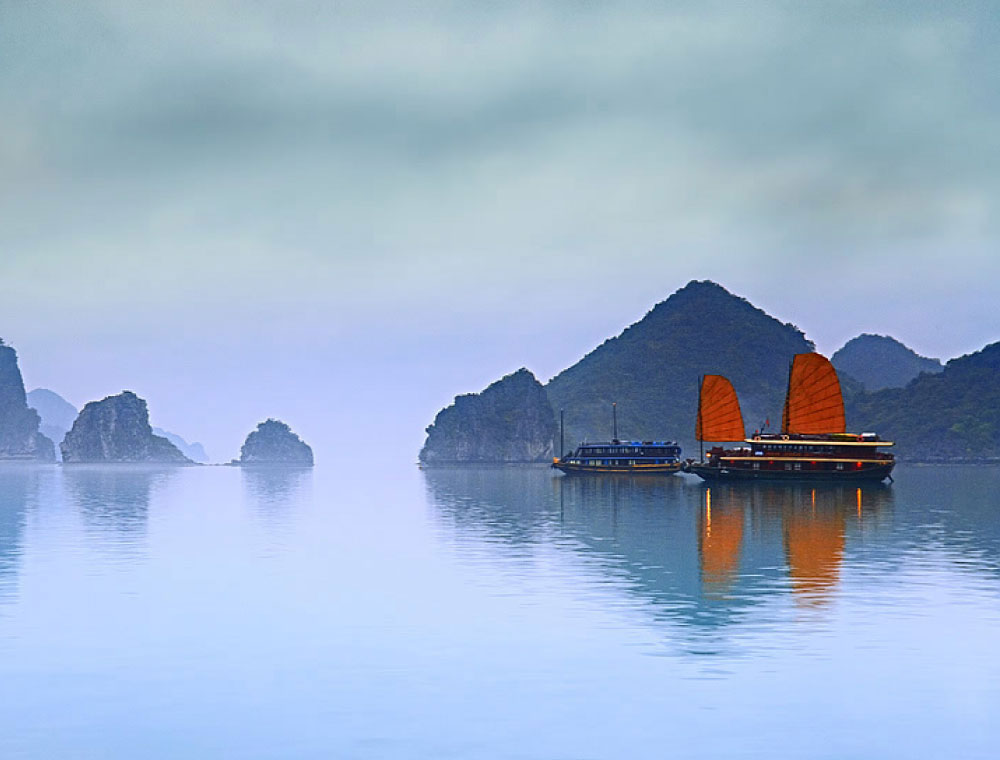
Hanoi is arguably Asia's most charming capital city. Hanoi, meaning ‘embraced by the river', is a city of broad, tree-lined boulevards, elegant French villas and colonial-era buildings painted in muted hues of mustard and white. It is also one of Asia's greenest cities with an abundance of parks and lakes as well as a host of cafes and art galleries and an Old Quarter steeped in history. By day the city hums with commerce and moves at motorbike speed; by night the city is an enchanting, 19th century Asian village best experienced from the seat of a silent cyclo.
Hanoi sits astride the banks of the Red River, Vietnam's second longest river. Beneath modern-day Hanoi lie artefacts and relics of the early Bronze and Iron ages, dating back to 2,000BC. The city was officially founded by Emperor Ly Thai To, who in 1010 renamed the area Thang Long or Soaring Dragon. Soon after, some of the city's oldest structures were built including the Temple of Literature, one of the oldest universities in the world.
In the 17th and 18th centuries the city experienced rapid growth due to the expansion of foreign trade. In 1786, the Tay Son Army from the south invaded northern Vietnam and united the country. During the Tay Son reign the capital was moved south to Hue, where it remained throughout the Nguyen Dynasty. Indeed Hanoi had to wait until 1831 to regain its former name, when Emperor Minh Mang established it as the capital of the Northern Province. The city's main period of growth stemmed from the arrival of the French in 1888. Fortunately, many of the old boulevards and residences have survived and today are used to house Foreign Embassies and Government institutions. From 1902 until 1953, the city served as the capital of French Indochina. In 1945, Ho Chi Minh proclaimed in his independence speech in Ba Dinh square, that Hanoi would henceforth be the capital of Vietnam. Today, Hanoi is a bustling city of nearly 7 million people.
BA BE LAKE
Ba Be Lake, 250 kilometres north of Hanoi, is Vietnam's largest naturally occurring lake and is dubbed, ‘the precious jade of Vietnam’. The lake is surrounded by stunning limestone cliffs, beautiful waterfalls, caves and dense evergreen forests which are inhabited by Tay, Dao and Hmong ethnic minorities. Many animals including bears, tigers and one of Vietnam’s rarest and most endangered primates, the Tonkin snub-nosed langur live in a few isolated communities on the fringes of Ba Be park, but nearer the lake there’s a good chance of spotting the more common macaque monkeys, herons and garrulous, colourful flocks of parrots. The spectacular lake is 7 kilometres in length and more than a kilometre across at its widest, the surface is so tranquil that people can even see the lake bed. Vietnamese legend says that the town was once a popular area for festivals, during one such festival a witch disguised as a beggar arrived asking for help. The entire town ignored her and tried to chase her out of the area, except for a widow and her son who looked after her, in return she gave them magic rice. She then proceeded to flood the entire town as revenge, creating Ba Be Lake in the process, the mother and son used the magic rice as a canoe and paddled to safety. In fact, the lake was formed approximately 200 million years ago and with its unspoiled landscape, still offers a haven of peace and tranquility away from the bustle of city life
HO CHI MINH MAUSOLEUM
Visiting Ho Chi Minh's mausoleum is an unforgettable experience. Inside an imposing building lies the embalmed body of the founder of modern Vietnam. When visiting the mausoleum the following rules need to be observed: No short sleeves & skirts are allowed. Silence should be observed when entering the tomb and definitely no photographs (in fact all bags have to be left outside). It’s quite an experience as you queue with many Vietnamese, some of whom have traveled many miles to make the pilgrimage. The mausoleum is a unique opportunity to reflect upon the life of one of the 20th century's more revered historical figures. Next to the mausoleum is a replica of "Uncle Ho's" wooden house on stilts.
TEMPLE OF LITERATURE
Dating back to 1070, the Temple of Literature was the site of Vietnam's first university and was used to educate the sons of the mandarin class. The complex consists of five separate courtyards with different paths that would originally have been reserved for the Emperor and his mandarins and highlighted by the Khue Van Pavilion. One of the courtyards contains the statue of Confucius guarded by two beautiful bronze storks standing on turtles. Another feature of the temple is the steles. Between 1442 and 1779, hundreds of stone tablets, or steles were erected to record the names and achievements of the graduates. Eighty-two of the steles remain and are considered the most valuable artifacts at the temple. The temple highlights the importance that Vietnamese society placed then and now on education.
ONE PILLAR PAGODA
Emperor Ly Thai Tong built one of Hanoi's most famous landmarks, the One Pillar Pagoda in 1049 in honor of the Goddess of Mercy. The pillar was destroyed in 1954, but the pagoda was quickly rebuilt. The design of the pagoda reflects the Buddhist belief that the world was created much as a lotus flower emerges from the water. The pagoda is built above a small pond covered in lotus blossoms.
HOAN KIEM LAKE
Hoan Kiem Lake is at the heart of Hanoi – the capital of Vietnam. In the morning, local residents gather and jog around a peaceful lake ringed by trees; or simply support each other complete Tai Chi practices. In the evening, more people would gather in lakeside cafes and ice-cream parlours to enjoy the peaceful atmosphere and share their daily events. The Lake also has a rich and colourful history too. In the 15th century, after Emperor Le Thai To had drove the invading Chinese with a magical sword, a giant tortoise seized his sword whilst he rowed in Hoan Kiem Lake. He took this sign as an intervention from above to signify that peace shall be restored. Thereafter, he renamed the lake to Ho Hoan Kiem or translated to “Lake of the Restored Sword”.
THE OLD QUARTER
A walk through the Old Quarter, also known as the 36 Streets offers a glimpse in to Vietnamese life from ages past. In the early 13th century, guilds and artisans clustered their shops around certain streets. As time went by the narrow lanes adopted the names of the particular guild or goods sold there. Hence you can still walk from Fish Street to Tin Street to Bamboo Street. It’s a great place to explore on foot with numerous photo opportunities. There are also two ancient houses in the Old Quarter that are especially worth visiting:
ANCIENT HOUSE: 87 MA MAY STREET
Built over 110 years ago, this house is one of the two ancient homes in Hanoi's Old Quarter, which were carefully restored as part of Hanoi's 990th Anniversary in 2000. The house is a typical Old Quarter "tube house" 2 meters wide and 60 meters long with open yards between rooms for air and light. The house is arranged strictly in accordance with "Feng Shui" rules and is vividly decorated in a traditional style.
ANCIENT HOUSE: 38 HANG DAO STREET
This house, built on the foundations of a 17th century trader's home has been renovated to reflect the architecture and decorative styles of old Hanoi. The first floor is designed for trading purposes and living accommodation, the second for the family altar and the act of worshipping.
HANOI OPERA HOUSE
The Hanoi Opera House is one of Hanoi's grandest buildings. The exterior is a delightful mix of French neo-classical design with shuttered windows, wrought iron balconies and tiles friezes. Construction of the Hanoi Opera House began in 1901 and was completed in 1911.
WATER PUPPET THEATRE
Water puppetry is a remarkable Vietnamese art form combining traditional music, fireworks and elaborate puppets floating gracefully on the water. The stories depict Vietnamese legends, peasant life and local festivals. The art form dates back to the 10th century and originally these plays would have taken place on lakes and ponds during the monsoon season. The stories remain the same but now the production takes place in a specially designed theatre with a stage knee-deep in water. The puppeteers are hidden behind a bamboo screen and the whole experience is both entertaining and amusing.
MUSEUM OF ETHNOLOGY
This is a must-see for anyone intending to visit either Mai Chau or Sapa, or indeed anyone interested in Vietnam’s cultural diversity. The museum is widely acknowledged as the best in the country and has an extensive display dedicated to Vietnam’s 54 Ethnic minority peoples. As well as the comprehensive array of exhibits inside, there are also traditional tribal houses reconstructed within the grounds.
QUAN THANH TEMPLE
Quan Thanh Temple was built during the reign of King Ly Thai To (1010 - 1028). The temple honors Saint Tran Vu, a legendary figure who helped King An Duong Vuong chase away demons during the construction of Co Loa Citadel. The central feature of the temple is a giant, black, bronze statue of Tran Vu cast in 1667.
TRAN QUOC PAGODA
With origins dating back to the 6th century Tran Quoc is one of the oldest pagodas in Vietnam. The pagoda's unique design features a visitor hall, two corridors and a bell tower. Inside are numerous statues, the most notable of which is the wooden statue of the Shakyamuri Buddha. The oldest stele was built in 1639 and depicts the pagoda's history. Several burial stupas in the garden are relics of one of the earliest Zen Buddhist groups in North Vietnam.
BAT TRANG CERAMICS VILLAGE
Bat Trang Ceramics Village (in existence for at least 500 years) is approximately 10km northeast of Hanoi and lies on the left side of the Red River bank. It specializes in crafting ritual objects, and producing household utensils such as bowls, plates, vases, cups and pots. Recently, the village has diversified its holdings and started to offer fine art ceramics and high quality porcelain. The village artisans' skills in providing handicrafts remain unmatched and non-rivalled.
BA BE PARK
The Park is a rainforest area with more than 550 named plant species and hundreds of wildlife species including; 65 (mostly rarely seen) mammals, 353 butterflies, 106 species of fish, four kinds of turtle, the highly endangered Vietnamese salamander and even the Burmese python. Ba Be birdlife is equally prolific, with 233 species recorded, including the spectacular crested serpent eagle and the oriental honey buzzard.
THE THAC DAU DANG (Dau Dang or Ta Ken Waterfall) consists of a series of spectacular cascades between sheer walls of rock, and is accessible by boat and on foot during day trips. Just 200m below the rapids is a small Tay village called Hua Tang.
PUONG CAVE - The tunnel-like Puong Cave is up to 50m high and 300m long and completely passes through a mountain. As many as 7000 bats, belonging to 18 species, are said to live in this spectacular cave.
FAIRY POND - "Fairy Pond" is a rock basin filled with crystal clear water which seeps through the surrounding limestone rock.



